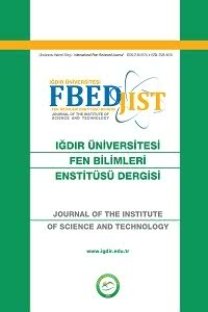Cichorium pumilum Jacq. (Asteraceae) Üzerine Anatomik Bir Çalışma
Anatomi, Asteraceae, Cichorium
An Anatomical Study on the Cichorium pumilum Jacq. (Asteraceae)
Anatomy, Asteraceae, Cichorium,
___
- Akçin EÖ, 2007. Morphological and anatomical characteristics of Cichorium intybus L., Tragopogon latifolius Boiss. and Tussilago farfara L. (Asteraceae). International Journal of Natural and Engineering Sciences, 1(3): 81-85.
- Akçin AT, Akçin A, 2009. Morphological and anatomical investigations on Turkish endemic Hieracium lasiochaetum (Bornm. & Zahn) Sell & West (Asteraceae). Journal of Applied Biological Sciences 3(2): 97-103.
- Azaizeh H, Saad B, Khalil K, Said O, 2006. The state of the art of traditional Arab herbal medicine in the eastern region of the mediterranean: a review. Evidance-Based Complementary and Alternative Medicine, 3(2): 229–235.
- Bremer K, 1994. Asteraceae. Cladistics & Classifcation, Timber Press. Portland, USA, 752p.
- Castro MM, Leitao-Filho HF, Monteiro WR, 1997. Utilizaçao de estruturas secretoras na identifcaçao dos generos de Asteraceae de uma vegetaçao de carrodo. Revista Brasileira Botany, 20: 163-174.
- Daniewski WM, Gumułka M, Drozdz B, Grabarczyk H, Błoszyk E, 1989. Sesquiterpene lactones. XXXVIII. Constituents of Picris echioides L. and their antifeedant activity. Acta Societatis Botanicorum Poloniae, 58(3): 351-354.
- Ekim T, 2012. Asteraceae. Şu eserde: Güner A, Aslan S, Ekim T, Vural M, Babaç MT (edlr.). Türkiye Bitkileri Listesi (Damarlı Bitkiler). Nezahat Gökyiğit Botanik Bahçesi ve Flora Araştırmaları Derneği Yayını, İstanbul, 140-141 s.
- Heywood VH, 1978. Flowering Plants of the World. Oxford University Press, Oxford, England, 336p.
- Khateeb AW, Hussein E, Qouta L, Alu’datt M, Al-Shara B, Abuzation A, 2012. In vitro propagation and characterization of phenolic content along with antioxidant and antimicrobial activities of Cichorium pumilum Jacq. Plant Cell, Tissue and Organ Culture (PCTOC), 110(1): 103-110.
- Kisiel W, Michalska K, 2003. Root constituents of Cichorium pumilum and rearrangements of some lactucin-like guaianolides. Zeitschrift für Naturforschung, 58(11-12): 789- 792.
- Lee KT, Kim JI, Park HJ, Yoo KO, Han YN, Miyamoto KI, 2000.
- Differentiation-inducing effect of magnolialide, a 1� - hydroxyeudesmanolide isolated from Cichorium intybus, on human leukemia cells. Biological and Pharmaceutical Bulletin, 23(8): 1005-1007.
- Matthews VA, 1975. Cichorium. In Davis PH, Matthews VA, Kupicha FK, Parris BS (edlr). Flora of Turkey and The East Aegean Islands. Edinburgh University Press. Edinburgh. Vol:5 626-629 p.
- Melo-de Pinna GFA, Menezes NL, 2002. Vegetative organ anatomy of Ianthopappus corymbosus Roque & Hind (AsteraceaeMutisieae). Revista Brasileira Botany, 25(4): 505-514.
- Metcalfe CR, Chalk L, 1950. Compositae. In: Anatomy of The Dicotyledons. Leaves, Stem and Wood in Relation to Taxonomy with Notes on Economic Uses. Oxford: Clarendon Press. 782-804 p.
- Metcalfe CR, Chalk L, 1979. Anatomy of Dicotyledons I. Oxford University Press, London, England, 288p.
- Milan P, Hayashi AH, Appezzato-da-Gloria B, 2006. Comparative morphology and anatomy of three Asteraceae species. Brazilian Archives of Biology and Technology, 49(1): 135- 144.
- Mueller RJ, 1991. Identifcation of procambium in the primary root of Trifolium pratense (Fabaceae). American Journal of Botany, 78: 53-62.
- Özörgücü B, Gemici Y, Türkan İ, 1991. Comparative Plant Anatomy. İzmir: Ege University, No: 129.
- Pyrek JS, 1985. Sesquiterpene lactones of Cichorium intybus and Leontodon autumnalis. Phytochemistry, 24(1): 186-188.
- Seago JL, Peterson CA, Enstone DE, 1999. Cortical ontogeny in ots of aquatic plant, Hydrocharis morsus-ranae L. Canadian Journal of Botany, 77: 113-121.
- Seto M, Miyase T, Umehara K, Ueno A, Hirano Y, Otani N, 1988. Sesquiterpene lactones from Cichorium endivia L., and C. intybus L. and cytotoxic activity. Chemical and Pharmaceutical Bulletin, 36(7): 2423-2429.
- The Plant List, 2013. Version 1.1. http://www.theplantlist.org/. (Erişim tarihi: 18 Eylül, 2015).
- Uyanık M, Kara ŞM, Gürbüz B, Özgen Y, 2013. Türkiye’de bitki çeşitliliği ve endemizm. Ekoloji Kongresi, 02-04 Mayıs 2013, Tekirdağ.
- Yılmaz N, 2009. Jurinea Cass. (Asteraceae) Cinsine ait bazı türlerin anatomik özelliklerinin sistematik açıdan karşılaştırılması. Afyon Kocatepe Üniversitesi Fen Bilimleri Enstitüsü, Yüksek Lisans Tezi, 80s.
- ISSN: 2146-0574
- Yayın Aralığı: 4
- Başlangıç: 2011
- Yayıncı: -
Celalettin GÖZÜAÇIK, Abdullah İREÇ
Atlarda Alaca Don ve Türkiye’deki Alaca Atlar
Abdurahman KÖSEMAN, İbrahim ŞEKER
Bazı Silajlık Mısır Çeşitlerinin Kayseri Koşullarına Adaptasyonu
Diyarbakır İli Hayvansal Üretime Dayalı Gıda Sanayisinin Durumu
Muzaffer DENLİ, Ramazan DEMİREL, Abdullah SESİZ
Iğdır Yöresi Cevizlerinin (Juglans regia L.) Seleksiyonu
Ersin GÜLSOY, Tuncay KAYA, Mikdat ŞİMŞEK, Mücahit PEHLUVAN
